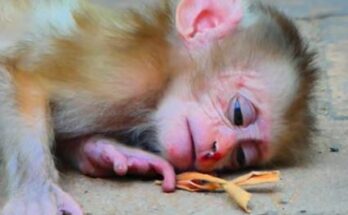In the heart of the jungle, where life thrives in its purest form, a mother monkey gently nurtures her young. Among the many lessons she must impart, one of the most significant is the process of weaning. This gradual transition from mother’s milk to solid food is not merely a physical shift but a deeply emotional and developmental milestone for both mother and infant. The art of weaning is a delicate balance of patience, love, and instinct, showcasing the mother’s unwavering dedication to her child’s independence.
The Significance of Weaning
Weaning is a natural process in the animal kingdom, essential for the young monkey’s growth and survival. In the early weeks of life, an infant monkey relies entirely on its mother’s milk for nourishment. The act of suckling not only provides sustenance but also strengthens the bond between mother and child, offering warmth, comfort, and security. However, as the infant grows, its nutritional needs evolve, requiring a transition to solid foods found in its environment.
For a mother monkey, weaning is not an abrupt severance but a gradual, carefully guided journey. She must ensure that her little one learns to forage and consume a variety of foods while still feeling the emotional safety of her presence. The process requires a blend of encouragement and gentle firmness—teaching her young to stand on its own while reassuring it that she is still there.
Patience in the Process
A mother monkey’s patience during weaning is a testament to her devotion. Initially, the infant resists change, clinging to the familiar comfort of nursing. It may whimper, protest, or stubbornly reach for its mother’s teat, refusing to accept the transition. Rather than pushing the infant away immediately, the mother adopts a more subtle approach.
She may begin by shortening nursing sessions, allowing her little one to suckle only briefly before guiding it toward a piece of fruit or leaves. She models foraging behavior, picking up food and chewing it in front of her infant, demonstrating that there are other sources of nourishment. Sometimes, she playfully nudges her baby toward food, encouraging exploration and curiosity.
Even when the infant grows frustrated, the mother remains calm. She understands that growth takes time and that her little one must adapt at its own pace. Her patience is not just a display of endurance but an expression of deep love—allowing her young to learn through experience while providing the comfort of her presence.
The Emotional Bond
The process of weaning is not just about food—it is an emotional journey. The mother and baby share an intense bond, built through countless hours of closeness and care. As the infant becomes more independent, this bond evolves rather than breaks. Though nursing less frequently, the baby still finds reassurance in its mother’s touch, her grooming, and her watchful gaze.
Even after weaning is complete, the mother continues to guide her young in other aspects of life—teaching social skills, protection from dangers, and the wisdom needed to navigate the wild. Her love is evident in every interaction, every patient lesson, and every moment of gentle guidance.
Conclusion
The art of weaning in monkeys is a profound reflection of a mother’s patience and love. It is a journey marked by small victories, quiet reassurances, and the gradual unfolding of independence. Through this process, the mother imparts not only the ability to eat solid food but also the resilience and confidence her young will need to thrive in the wild. In the end, the lesson of weaning is not just about survival—it is about love, growth, and the timeless bond between mother and child.


